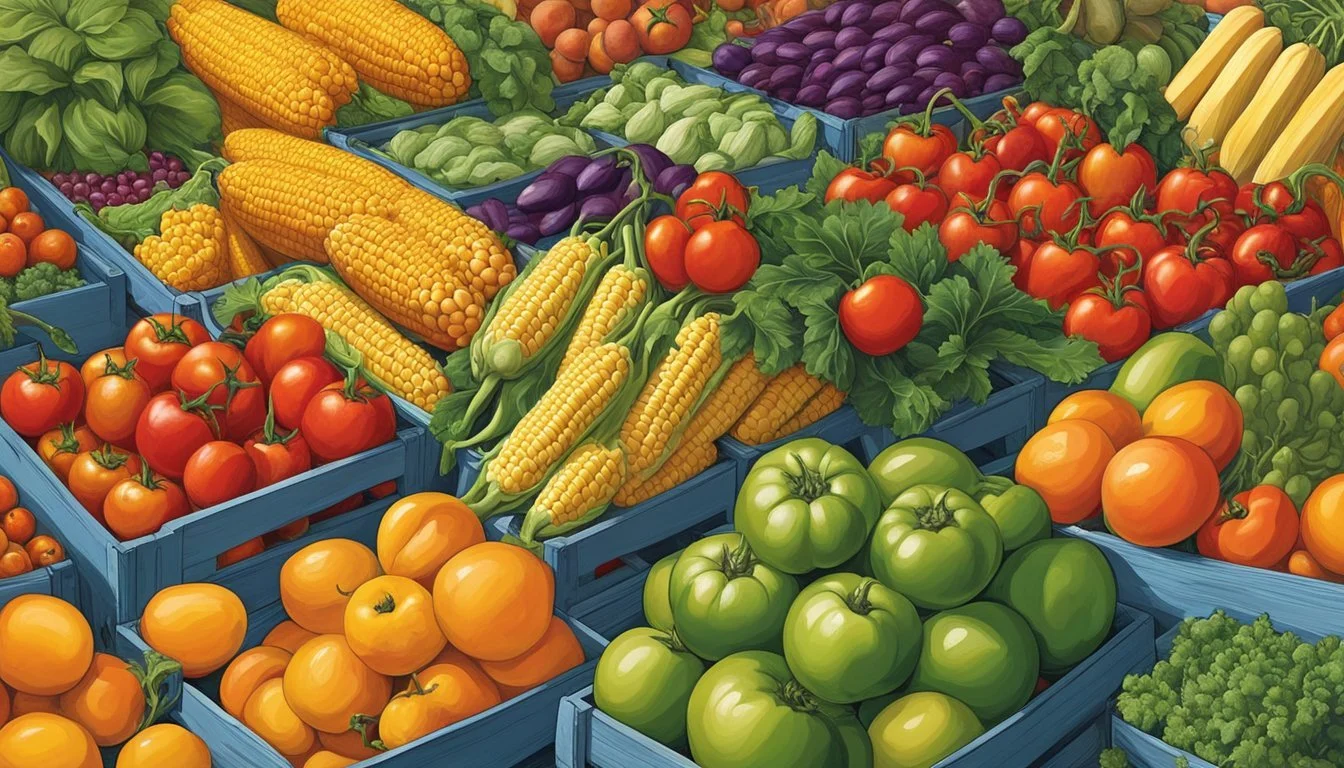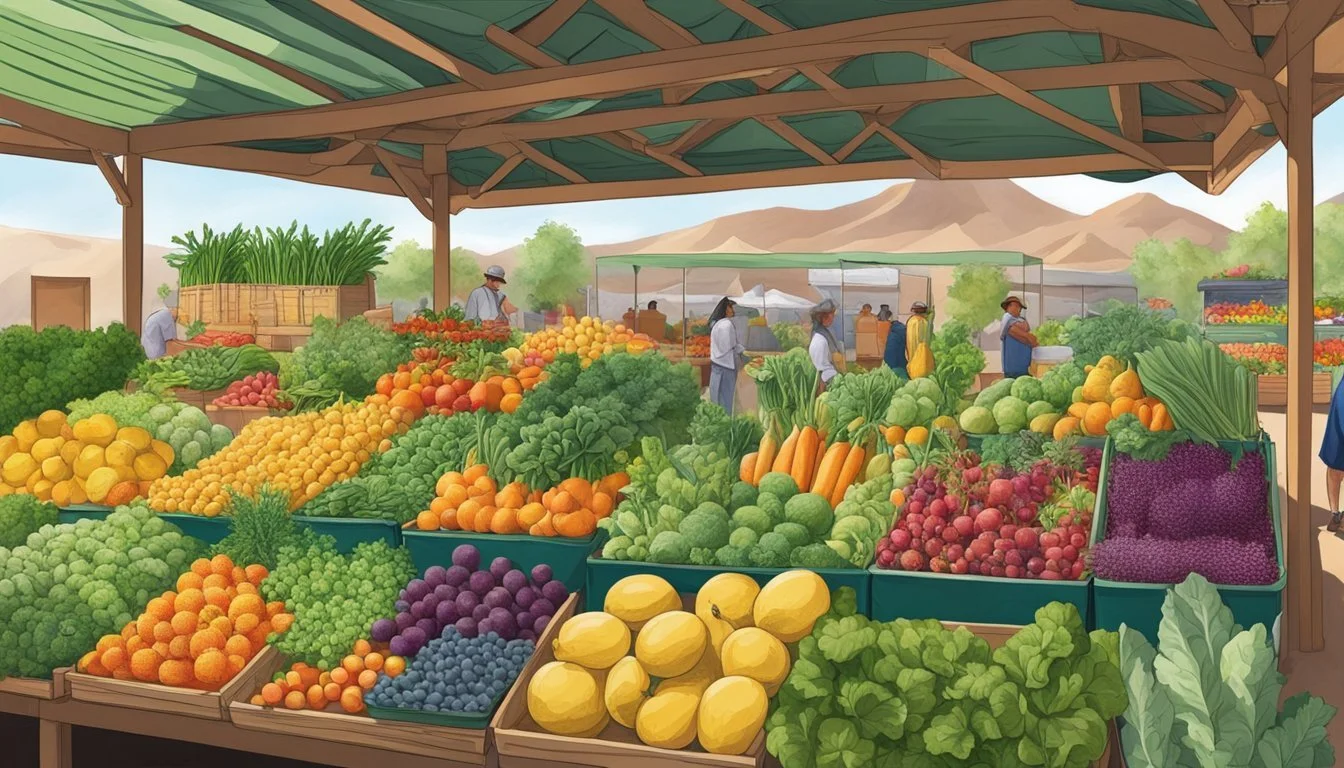New Mexico Seasonal Fruit & Vegetables in May
Your Fresh Guide
This Article is Part of our New Mexico Seasonal Fruit & Veg Calendar
In New Mexico, the arrival of May signals a shift in the agricultural calendar, as the last frosts recede and the growing season gains momentum. The state's diverse climate, ranging from arid deserts to high mountain areas, creates a unique environment for a variety of produce to flourish. Consumers eagerly anticipate the emergence of fresh, locally-grown fruits and vegetables, which begin to make their appearance in farmers' markets and grocery stores throughout the region.
During this period, the selection of vegetables begins to expand significantly. Leafy greens such as lettuce and spinach remain staples, while root vegetables like carrots are also at their peak. Meanwhile, aspiring gardeners and farmers take advantage of New Mexico's favorable conditions to plant future harvests, preparing for the abundance of summer.
While fruit options in May are typically more limited due to the cooler spring weather preceding it, the state’s produce calendar anticipates the ripening of certain fruit varieties. As temperatures increase, the groundwork is laid for the bountiful fruit seasons to follow, promising a rich selection of local produce in the upcoming months.
The Importance of Seasonal Eating
Eating seasonal fruits and vegetables aligns with the natural growing cycles, ensuring that consumers enjoy the freshest and tastiest produce. Seasonal eating fosters a greater connection with the local environment and its weather patterns, which influence the growth and flavor of produce.
In the dynamic climate of New Mexico, May brings a temperate season conducive to growing a range of fruits and vegetables characterized by fullness of flavor. Consuming produce in season often results in a more nutritious diet, as freshness is a key factor in nutritional content, and fruits and vegetables can lose nutrients quickly once harvested.
Taste is also significantly enhanced when fruits and vegetables are allowed to ripen naturally in their appropriate season. The local weather provides ideal conditions that contribute to the development of rich flavors, which are optimal during the peak season of ripeness.
Purchasing in-season produce supports local farmers and the regional economy. It reduces the carbon footprint associated with long-distance transportation when items are grown and consumed within the same geographical area.
In summary, seasonal eating contributes to better taste, nutrition, and environmental sustainability while also bolstering the local economy.
Month Seasonally Available Produce in New Mexico May Apricots, Cherries (how long do cherries last?), Lettuce, Spinach, Asparagus Strawberries, Radishes, Garlic, Spring onions
May Climate and Agriculture in New Mexico
In May, New Mexico's climate is characterized by warmer temperatures and the anticipation of the summer heat. Farmers and agricultural enthusiasts observe a significant change as the state transitions from the coolness of spring to the warmer days indicative of oncoming summer.
Weather patterns in May typically include mild to warm days with the occasional risk of late spring frosts, particularly in the northern parts of the state. The central and southern regions generally enjoy a more consistent rise in temperatures. This is a crucial period for agriculture as the weather greatly influences planting decisions and the success of crop germination and growth.
Agriculturally, May is a busy month for farms in New Mexico. With the last frost dates usually passing, it's an optimal time for planting a variety of crops. Farmers carefully monitor weather forecasts to protect tender plants from any unexpected late-season freezes.
Typical crops that are sown or flourish in May include:
Vegetables: tomatoes, peppers, and squash
Fruits: late-season apples and berries
Irrigation becomes increasingly important as precipitation levels can be low, requiring farmers to ensure adequate water supply for their crops. Farming practices must adapt quickly to the dry conditions that prevail in the state.
The agriculture sector in May also focuses on soil preparation, pest control, and the enrichment of fields to optimize crop output. With consistent, knowledgeable management, May can set a positive tone for the forthcoming growing season in New Mexico.
Key Seasonal Fruits in May
In New Mexico, May signals the bloom of various fruits that can be enjoyed for their freshness and taste. Highlighting the seasonal fruits during this month, one can expect to find a variety of options including:
Strawberries: Often at their sweetest, these berries are perfect for eating fresh or including in desserts.
Cherries: A favorite for many, cherries start to make their appearance, offering both sweetness and a slight tartness.
Apricots: These fruits come into season in May and are great for fresh eating or in jams.
Peaches: While still early, some varieties of peaches may begin to be available, especially towards the end of the month.
Here is a simple list of the fruits typically in season in May:
Strawberries
Cherries
Apricots
Early Peaches
It's less common to find local apples in May since they are typically harvested in the fall. Consumers interested in apples may find stored varieties from the previous season.
These fruits offer New Mexicans a chance to enjoy locally grown, fresh produce that contributes to a sustainable and healthy diet. When purchasing these fruits, one can expect a burst of natural flavors that are representative of the region's agricultural offerings. Whether incorporated into recipes or enjoyed on their own, these fruits provide versatility and nutritional benefits.
Key Seasonal Vegetables in May
In May, New Mexico's vegetable planting and harvest season is in full swing, with a variety of vegetables reaching their peak. Gardeners and farmers alike are busy bringing a selection of nutritious and flavorful vegetables to the markets.
Spinach and kale are leafy staples during this time, famous for their versatility and health benefits. Rich in vitamins and minerals, these greens are perfect raw in salads or as cooked accompaniments.
Lettuce and arugula, also part of the leafy green family, offer crisp textures and fresh flavors that are essential for spring salads. Their tenderness is highest in the cooler early weeks of May.
Chard, with its vibrant colored stems and dark green leaves, stands out in any dish. It is a superb source of iron and can be used in everything from stir-fries to smoothies.
| Leafy Greens | Availability |
|--------------|--------------|
| Spinach | Peak Season |
| Kale | Peak Season |
| Lettuce | Peak Season |
| Arugula | Peak Season |
| Chard | Peak Season |Root vegetables remain significant in May, with carrots and beets offering sweet earthiness to dishes, whether roasted, boiled, or raw.
Radishes, with their peppery crunch, are ideal for adding a zesty note to dishes. They can be eaten raw as a snack or sliced into salads for a spicy kick.
Spring greens arrive in the form of young lettuce and spinach leaves, providing a tender option for cool dishes as the weather begins to warm.
| Root Vegetables | Characteristics |
|-----------------|-----------------------|
| Carrots | Sweet, Earthy |
| Beets | Rich, Deep Flavor |
| Radishes | Peppery, Crunchy |New Mexico favors these vegetables in May due to their adaptability to the state’s unique growing conditions, making them abundant and accessible. Chefs and home cooks alike treasure them for their contribution to a colorful and healthful culinary landscape.
Herbs and Other Produce
In May, New Mexico's mild climate fosters the growth of various herbs and other produce. Gardeners and farmers see a robust yield of herbs such as basil, sage, and garlic, which are fundamental to local cuisine.
Basil thrives in the warmer temperatures, its leaves offering a fresh, peppery flavor useful in dishes from pestos to salads.
Sage, known for its earthy and slightly peppery taste, is commonly used in New Mexico for seasoning meats and in medicinal teas.
Garlic bulbs reach maturity and are harvested. Their pungent flavor is highly regarded in the culinary scene, enhancing the taste of a diverse range of dishes.
May is not solely about herbs; the following are also harvested:
Produce Description Arugula Peppery, leafy green that enhances salads and sandwiches Carrots Crunchy and sweet, perfect for both raw and cooked uses Salad Greens Various types including spinach for fresh, leafy mixes Radishes Spicy and crisp, offering a zesty bite to dishes
Farmers' markets begin to feature these fresh ingredients prominently, offering consumers a taste of the best local flavor. Home cooks and professional chefs alike anticipate the arrival of these herbs and vegetables to enrich their culinary creations with depth and freshness.
Harvesting and Selecting Produce
In May, New Mexico's farmers are busy with the harvest of both vegetables and fruits. When selecting fresh produce, customers should prioritize raw vegetables like broccoli, carrots, and lettuce, which are known for their crisp texture and robust flavor, especially when harvested at their peak.
Vegetables:
Broccoli: Look for firm, dark green heads.
Carrots: Should be firm and smooth.
Lettuce: Fresh lettuce will have crisp leaves with no browning edges.
Fruit options are more limited in this month due to the climatic conditions. However, some hardy varieties are still available and can be picked from local orchards.
Fruits:
Cherries: Choose plump, firm ones with bright, glossy skin.
When sourcing produce, buyers should consider visiting local farmers' markets. There, one can often find the freshest selections, cultivated within the region, allowing not only for support of local agriculture but also ensuring a shorter farm-to-table journey — which frequently translates into superior taste and nutrient retention.
It's also beneficial for shoppers to engage with farmers directly, gaining insights into the best current picks and potentially discovering new varieties of seasonal fruits and vegetables. This interaction ensures that consumers have access to both the freshest options and the knowledge necessary to choose the best possible produce.
Health Benefits of Seasonal Fruits and Vegetables
Eating seasonal fruits and vegetables in May provides several health benefits. Nutrient density tends to be higher in produce that is in season. For instance, leafy greens such as spinach harvested in the spring offer high levels of vitamin C, iron, and antioxidants, which play a role in immune system function and cellular repair.
Variety is another advantage of seasonal eating. Rotating through different fruits and vegetables introduces a diverse array of nutrients to one’s diet. This includes everything from vitamins, minerals, to phytochemicals, which may contribute to reducing one’s risk of chronic diseases.
Consuming seasonal fruits like cherries and strawberries in New Mexico provides antioxidants such as vitamin C and anthocyanins. These compounds support heart health and may have anti-inflammatory properties. Additionally, vegetables like asparagus, available in May, are rich in dietary fiber, supporting digestive health.
Here's a brief overview of the benefits:
Leafy Greens: Rich in iron and vitamins A, C, and K, and often contain folate, which supports cell growth and repair.
Fruits: Provide dietary fiber, which promotes satiety and aids in digestive health, as well as a variety of vitamins and minerals.
Incorporating seasonal produce into meals ensures a diet with a balance of essential nutrients that support overall health and well-being. It also often translates to better flavor and fresher produce, as these items are typically harvested at their peak of ripeness.
Preparing and Storing May's Seasonal Produce
Storing Fruit: May introduces a variety of fruits in New Mexico. Berries, which start to come into season, should be kept in the refrigerator in a single layer to reduce squishing and spoilage—consume within a few days for best quality. Stone fruits, like apricots and cherries, can ripen at room temperature before transferring to the fridge.
Vegetable Storage: New Mexico's May vegetables include leafy greens and root vegetables. Lettuce and salad greens should be washed, dried, and stored in the crisper with a paper towel to absorb excess moisture. Radishes and carrots stay crisp in the fridge, best kept in breathable bags with tops removed.
Recipes and Cooking:
Salad: Fresh greens and herbs can be used directly in salads. Dress lightly to appreciate their natural flavors.
Pesto: Turn abundant herbs into pesto for a versatile condiment.
Preservation Techniques:
Freezing: Blanch vegetables before freezing to preserve texture and flavor.
Canning: Pickling is an option for some vegetables, like radishes.
Herb Storage: Fresh herbs can be wrapped in a damp paper towel and placed in a bag in the fridge, while woody herbs like rosemary last longer when stored loosely covered at room temperature.
When preparing these items, cooks should consider the ingredient's peak freshness and use methods that will highlight their natural flavors. Simple preparations can often be the best way to enjoy the season's bounty.
Supporting Local New Mexico Agriculture
May marks a vibrant period for New Mexico's agricultural bounty, offering a plethora of opportunities for individuals to support local farms and bolster the community economy. Local farms thrive on the direct-to-consumer relationship, which is reinforced through farmers markets and community-supported agriculture programs (CSAs).
Farmers Markets: These hubs act as pivotal points for buying fresh, in-season produce directly from the growers. By shopping at these markets, one sustains individual farmers and contributes to the local economy's circulation.
Economic Impact: Money spent on local farms stays in the community and helps to maintain the agricultural landscape that New Mexico is known for.
Farm-to-Table Connection: Direct purchasing fosters a deeper understanding of where food comes from and promotes sustainable agriculture.
Community Supported Agriculture: CSAs encourage residents to invest in local farms by paying for a share of the harvest upfront. This shared-risk model provides farms with early-season capital and ensures that consumers receive fresh, seasonal produce.
Consistent Support: Prepaying for produce at the start of the season helps farmers plan and budget more effectively.
Share Season: Typically spanning from May to October, CSAs offer a regular supply of fresh goods, aligning consumer habits with the natural growing cycle.
By valuing local agriculture, New Mexicans contribute not just to the economy but also to the preservation of farming traditions and the promotion of food sovereignty. The impact extends beyond individual health benefits from fresh produce—it's a commitment to environmental stewardship and economic resilience.
Seasonal Eating Calendar
In New Mexico, the availability of fruits and vegetables changes with each passing month. This calendar serves as a guide for what consumers can typically find at farmers' markets and stores.
May
In May, one can find a variety of leafy greens and root vegetables. The list of available produce includes:
Spinach
Lettuce
Radishes
Carrots
Beets
June
Stone fruits come into season in June, along with other warm-weather vegetables:
Cherries
Apricots
Summer squash
Cucumbers
Tomatoes
July
By July, the range of fruits and vegetables grows substantially. Season highlights are:
Melons
Corn
Green beans
Peppers
August
August boasts peak seasonality for many crops. The offerings expand to include:
Apples
Pears
Eggplants
Okra
September
As summer transitions to fall, September's palette shifts slightly. Markets typically carry:
Grapes
Plums
Pumpkins
Sweet potatoes
Kale
Closing Thoughts on Seasonal Eating in New Mexico
In May, New Mexico's farms bring a refreshing wave of local produce to the table. Consuming what the state yields not only supports local farmers but also contributes to better health through the intake of a variety of fresh, nutrient-rich foods.
Local Produce: One finds that the assortment of fruits and vegetables available in May includes strawberries, cherries, as well as leafy greens such as spinach and lettuce. Patrons often appreciate the flavor and quality of these goods, noting their marked difference from off-season imports.
Health Benefits: Nutritionally, the body benefits from the seasonal consumption of these items. The food is at its peak in both flavor and nutritional value when it's harvested at the right time and consumed shortly thereafter.
Supporting Farmers: When consumers in New Mexico choose local and seasonal foods, they are directly bolstering the state's agricultural framework. This choice sustains the economic vitality of farms and ensures that they are operational for future generations.
Environmental Impact: It's also worth highlighting the lower carbon footprint associated with seasonal eating. The reduced need for transportation and storage for state-grown produce minimizes greenhouse gas emissions, serving the broader interest in environmental stewardship.
Dietary Variety: Lastly, the rotation of crops with the seasons naturally diversifies one's diet. This is essential for both maintaining a robust immune system and reducing the risk of developing chronic diseases.
By embracing the rhythm of nature's offerings, New Mexicans extend their commitment to health, economy, and environment. May's seasonal yield reaffirms the state's capacity to provide its population with a cornucopia of beneficial foods.












